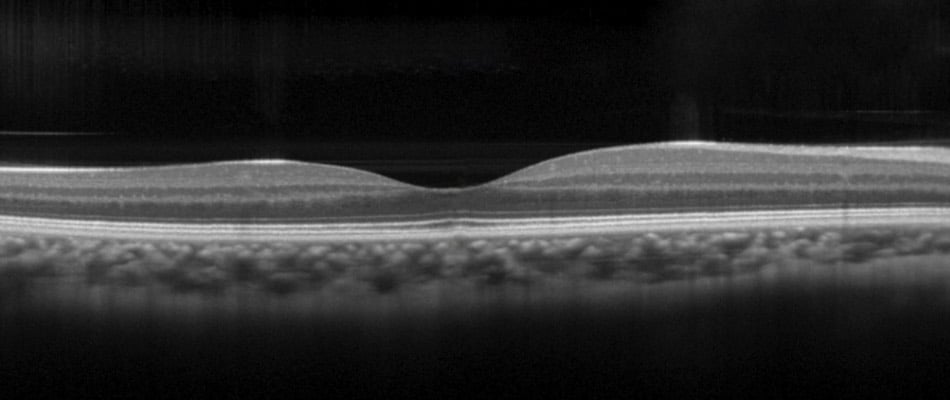In case of unclear symptoms or a well-founded suspicion of macular degeneration, OCT images can help. However, health insurance companies pay for the examination only in a few exceptional cases. In patients with good visual acuity and no abnormalities, experts consider OCT scans unnecessary.
In general, regular OCT scans are recommended for people who have a higher risk of certain eye diseases. The following list shows patients who particularly benefit from follow-up with an OCT scan.
- Patients with age-related macular degeneration (AMD)
- Various retinal diseases and macular changes
- Venous occlusions of the retina
- Changes of the optic disc or increased intraocular pressure
- Patients with diabetic retinopathy
- Diagnosis and follow-up of glaucoma
- Patients with unclear visual deterioration
- Epiretinal gliosis (fine membrane over the center of the retina)
- Cystoid macular edema (swelling of the retina)
How often an OCT has to be done is decided by the treating ophthalmologist. Depending on the findings of the ophthalmologist, this can mean a period of six months to several years between two OCT scans is recommended by the specialist.
Is Optical Coherence Tomography Necessary?
An OCT scan is necessary when a finding must be excluded or confirmed. Some anomalies can only be measured and documented with an OCT scan.
For example, a hole in the center of the retina can only be visualized and measured with OCT. Documentation of the extent of inflammatory changes as accurately as possible is of great importance in order to detect an increase in size at an early stage.
Similarly, the affected person usually recognizes problems of glaucoma only when it is too late, because here it comes to a slow death of certain photoreceptors. This is only noticeable to the affected person at a very advanced stage, because visual acuity is not affected for a long time.
A decrease in retinal thickness in the area of the optic disc and in the area of the macula (yellow spot) is an early sign of glaucoma.
The risk of developing glaucoma increases with age. Just under four percent of people aged 75 to 89 have glaucoma. From the age of 40, glaucoma screening should take place once a year.
It is therefore recommended that the screening examinations are as accurate as possible. If the OCT scan is not performed, less data is available for diagnosis. Whether the OCT scan is right for you individually decides your ophthalmologist.
What Is an OCT Scan Used For?
OCT enables a graphical representation of the retina that is absolutely painless for the patient and provides high-resolution slice images in a cross-section. Based on the OCT findings, the specialist can assess the retinal layers, for example their thickness or fine structure. Optical coherence tomography is primarily used in the initial diagnosis of various retinal diseases such as age-related macular degeneration.
With an OCT scan, it can be determined whether and how much fluid is located in the area of the retina. It is also possible to see where the fluid collects: e.g. under the retina or in the retina. These fluid accumulations can cause typical symptoms such as blurred and distorted vision.
During follow-up, the ophthalmologist can see if there is little to no fluid in or under the retina in the OCT image. Thus he can show if the treatment is effective. Simply put, through these regular OCT examinations, the ophthalmologist can detect worsening and improvement of wet macular degeneration. And compared to other imaging methods OCT scans make early diagnostics more reliable and efficient.
Are OCT Scans Safe?
OCT scans have no side effects or adverse effects on your eyes. The examination with the OCT procedure is performed without touching the back of the eye and without dripping using a laser within a few seconds.

OCT scans are also used before cataract surgery. This way the ophthalmologist has more data during the consulting to choose the optimal lens for the patient.
When toric lenses and multifocal lenses are used, the professional societies of ophthalmic surgery recommend that an OCT scan be performed.
Even slight changes in the retina can have a significant impact on the choice of the right lens. During the OCT examination, the tissue structure of the macula in particular is examined.
If restrictions are found here, then multifocal lenses, for example, are less suitable because these lenses place a high demand on the performance of the macula.
Especially in the case of existing changes in the macula, so-called blue filter lenses can counteract early retardation and provide better protection against existing diseases, such as age related macular degeneration.
How Much Does an Oct Scan Cost?
The cost of an OCT scan starts at about $40 and can go up to $140. This includes at least 2 scans for each eye and the analysis and discussion of the results with your Optometrist. The price depends mainly on the service of and the training of the opthalmologist. Also, the consultation and its calculation of the doctor plays a role.
How Accurate Are OCT Scans?
Reproducible measurement values can be determined for OCT scans in the two-digit micrometer range. However, the accuracy of OCT scan s is not equally good in all axial positions. axial resolution is better than compared to lateral resolution.
Thus, the thickness of retinal layers can be analyzed more accurately with OCT imaging than when compared to calculating the surface area of the retina or a specific distance on it.
Sources of Error in an OCT Scan
Pathologic finding patterns may not only be overlooked, but may also be confused with similar finding patterns.
Image artifacts hinder the visual and automatic evaluation of OCT image data. Failure to recognize or ignoring artifacts can lead to erroneous interpretation and ultimately to incorrect medical decisions. Artifacts could be caused, for example, by inappropriate illumination or movement.
The interpolation of the measured values and the interpretation of the algorithms during the processing of the scans can lead to errors.
